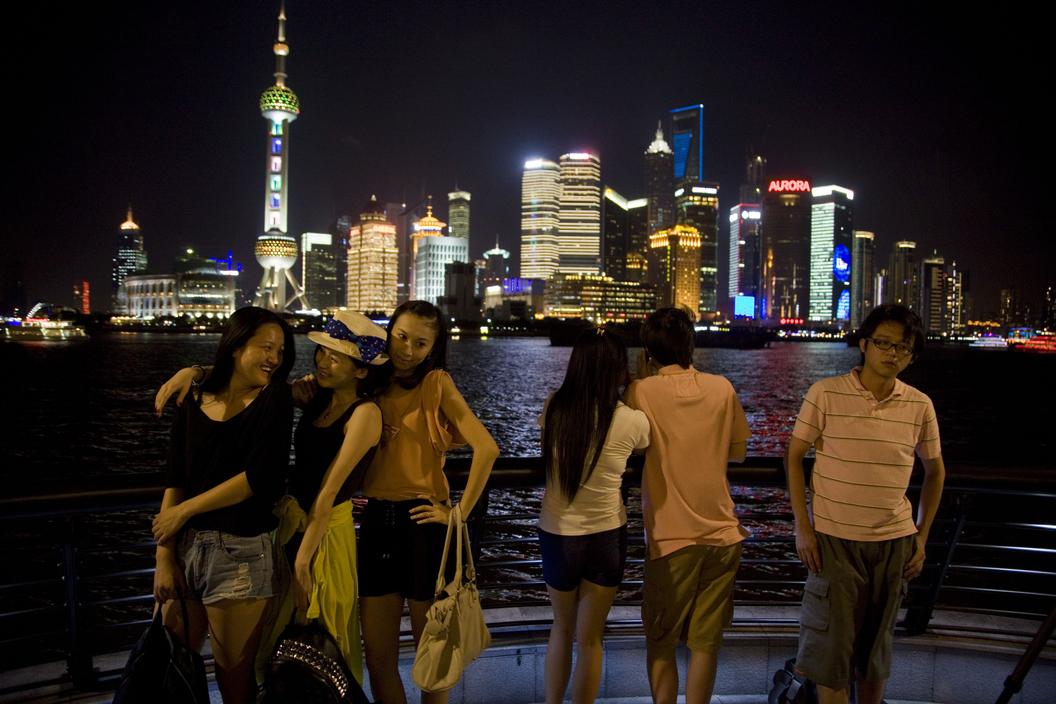Remember street gangs? Jets and Sharks on Broadway, “juvenile delinquents” in the newspapers, and earnest discussions in the magazines, schools, and churches about “teenagers”: these were parts of a mid-century public discourse about the social and moral effects of modern development. Now that gangs are murderous million dollar cartels, the allegory is less appealing close to home, which may be why it can be found in this photo from Shanghai.
Six adolescents stand before a dazzling backdrop of the city aglow in the night. Of course, they also are in the city, which is showcased by its most highly developed, cosmopolitan urban core of corporate skyscrapers. But a river separates them from the concentration of wealth, which is set above them a bit like heaven. Because the image is divided high and low by the distant shoreline, the visual grammar makes the high-end architecture an ideal that is set over the reality below. Because their heads just break the line, they may be tending toward the bright lights, as is suggested also by the middle-class consumer consumption evident in their clothing and accessories. Indeed, one implication is that they are destined to become the next generation of adults living within Chinese capitalism.
One might ask, then, “how are they doing?” They photo suggests several answers. One is that they are doing fine, because they obviously are sharing in the prosperity that they will one day claim as their own. The city has already been built while they are being prepared to thrive there, so life is good. Indeed, one might think that China can skip the anxieties about modernization damaging kids who then damage society; no one is going to cross the street to avoid this group. A related implication is China has now developed well enough that its children can experience the distinctively modern definition of adolescence, which is considerably elongated for extended education and uniquely susceptible to developing a youth culture dominated by popular entertainment and merchandising. That may be good news and bad news, but it implies a universality for modern societies that can hide other differences–say, the fact that everyone in the picture very probably is a single child who knows a lot more about loneliness than most children in the West.
Another implication might be that China is now in the adolescent phase of modern capitalist development: growing by leaps and bounds, and my goodness, look at how much carbon that kid eats! Thus, virtually anything can be excused as “growing pains,” as long as the kid doesn’t pick up a gun or kill someone with the car or get pregnant; so, no military expansion and please be careful about emissions, but otherwise we’ll wait it out. Such a view is very condescending, of course, but it is sure to have plenty of adherents, perhaps because of that.
I think the photo does better than that, however. There is another dimension to the image, one suggested by its dark tonality and the kids’ separation from the cityscape. For example, these qualities push universality further to suggest that China’s children are destined for other uniquely modern experiences as well, and not least the social fragmentation and anomie that are side effects of modern development. Furthermore, we have to pay attention to the photo’s almost painful depiction of typified social behavior. As the eyes move from left to right, we see three girls hugging, a girl and a boy close together, and a lone boy. Thus, in the center, the teen dream of romantic coupling, and on each side (girls on the left, boys on the right), the gender segregation in which young people spend most of their time. It’s not just a matter of time, however, as the boy on the right seems quite alone and at least pensive or even sad. If you look closely, you’ll see that the girl on the right side of the threesome also is a bit outside of that grouping gesturally and emotionally. The intensive social awareness of adolescence inevitably is accompanied by separation, self-consciousness, and sadness. Despite their evident prosperity and bright future, life still could be tough.
So it is that I think the photo provides an allegory after all, and one that is not just about China. One of the major questions of the 21st century is how to live well in a world dominated by modern capitalism. As China demonstrates, the shopping mall is one answer to that question, and it shouldn’t be dismissed out of hand. But it is not enough, nor are GDP, the level of foreign investment, and other macroeconomic variables the full measure of success. The trick is to bring everyone to a just and sustainable standard of living, and give everyone a chance to thrive and contribute beyond that, and to do so in a manner that balances “creative destruction” with the need to preserve proven social goods and individual dignity. Stated in terms of the photo above, the immensely powerful superstructure of modern civilization has to be a place where the experience of those not in power still comes first.
Photograph by Bruno Barby/Magnum Photo. The rest of Barby’s photo essay on Shanghai is here.

Punks in China and Holland:
http://www.efn.org/~hkrieger/f1718.gif
from the photo series, “FotoFestival Naarden”
http://www.efn.org/~hkrieger/fotofest.htm